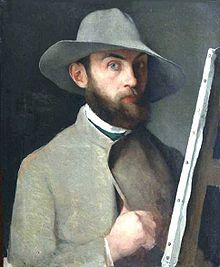
Charles Maurin (1 April 1856 – 22 July 1914) [1] was a French painter and engraver in a variety of styles.
Life and career
Maurin was born in Le Puy-en-Velay ( Haute-Loire, Auvergne-Rhône-Alpes). He was awarded the Prix Crozatier in 1875, and used the funds to go to Paris to study art at the Ecole des Beaux-Arts under Jules Lefebvre from 1876 to 1879. [2] He also studied at the Académie Julian, where he eventually taught. [2] He exhibited at the Salon of French artists and became a member of the Society of French Artists in 1883. [2] He was a friend and mentor of the painter Félix Vallotton. [3]
Art
Maurin received the support of Vollard and was a friend of Toulouse-Lautrec—who had his first individual exhibition with him in 1893—and also of many other artists, including François-Rupert Carabin and the entertainer Aristide Bruant. A notable symbolist work of his is Maternity, a study of motherhood. Inspired by Japanese artists, he revolutionized the technique of etching, and also produced woodcuts. In 1891 he patented a method of color printing. [2] He contributed to La Revue Blanche, directed by Félix Fénéon, and Les Temps nouveaux, published by Jean Grave. [4]

In 1893 Maurin produced a commemorative woodcut of the anarchist Ravachol, depicting him in front of the guillotine against a rising sun and a field of grain. The art historian Howard G. Lay has commented on the piece's " japoniste perspective" and "robust linearity", its "schematization of form" and "stylistic overtures to artless sincerity", which he argues lend the picture an "iconic bearing" and its subject a "saintly stature". [5] It was later featured on the cover of the early 1900s bomb-making handbook La Salute è in voi. [6]
Charles Maurin died on 22 July 1914 in Grasse, southeast France. [2]
References
- ^ Benezit, Emmanuel (2006). Benezit Dictionary of Artists, Maele-Muller. Grund. p. 592.
- ^ a b c d e Lymbery, Etrenne. "Maurin, Charles". Grove Art Online. Oxford Art Online. Oxford University Press. doi: 10.1093/gao/9781884446054.article.T056098
- ^ Newman, Sasha M., Félix Vallotton, Marina Ducrey, and Lesley K. Baier (1991). Félix Vallotton. New Haven: Yale University Art Gallery. pp. 17–18. ISBN 1-55859-312-8
- ^ "MAURIN Charles". 24 November 2020.
- ^ Lay, Howard G. (2001). "Beau Geste! (On the Readability of Terrorism)". Yale French Studies (101): 87. doi: 10.2307/3090607. JSTOR 3090607.
- ^ Avrich, Paul (1996). Sacco and Vanzetti: The Anarchist Background. Princeton University Press. p. 75. ISBN 978-0-691-02604-6.
External links
![]() Media related to
Charles Maurin at Wikimedia Commons
Media related to
Charles Maurin at Wikimedia Commons

Charles Maurin (1 April 1856 – 22 July 1914) [1] was a French painter and engraver in a variety of styles.
Life and career
Maurin was born in Le Puy-en-Velay ( Haute-Loire, Auvergne-Rhône-Alpes). He was awarded the Prix Crozatier in 1875, and used the funds to go to Paris to study art at the Ecole des Beaux-Arts under Jules Lefebvre from 1876 to 1879. [2] He also studied at the Académie Julian, where he eventually taught. [2] He exhibited at the Salon of French artists and became a member of the Society of French Artists in 1883. [2] He was a friend and mentor of the painter Félix Vallotton. [3]
Art
Maurin received the support of Vollard and was a friend of Toulouse-Lautrec—who had his first individual exhibition with him in 1893—and also of many other artists, including François-Rupert Carabin and the entertainer Aristide Bruant. A notable symbolist work of his is Maternity, a study of motherhood. Inspired by Japanese artists, he revolutionized the technique of etching, and also produced woodcuts. In 1891 he patented a method of color printing. [2] He contributed to La Revue Blanche, directed by Félix Fénéon, and Les Temps nouveaux, published by Jean Grave. [4]

In 1893 Maurin produced a commemorative woodcut of the anarchist Ravachol, depicting him in front of the guillotine against a rising sun and a field of grain. The art historian Howard G. Lay has commented on the piece's " japoniste perspective" and "robust linearity", its "schematization of form" and "stylistic overtures to artless sincerity", which he argues lend the picture an "iconic bearing" and its subject a "saintly stature". [5] It was later featured on the cover of the early 1900s bomb-making handbook La Salute è in voi. [6]
Charles Maurin died on 22 July 1914 in Grasse, southeast France. [2]
References
- ^ Benezit, Emmanuel (2006). Benezit Dictionary of Artists, Maele-Muller. Grund. p. 592.
- ^ a b c d e Lymbery, Etrenne. "Maurin, Charles". Grove Art Online. Oxford Art Online. Oxford University Press. doi: 10.1093/gao/9781884446054.article.T056098
- ^ Newman, Sasha M., Félix Vallotton, Marina Ducrey, and Lesley K. Baier (1991). Félix Vallotton. New Haven: Yale University Art Gallery. pp. 17–18. ISBN 1-55859-312-8
- ^ "MAURIN Charles". 24 November 2020.
- ^ Lay, Howard G. (2001). "Beau Geste! (On the Readability of Terrorism)". Yale French Studies (101): 87. doi: 10.2307/3090607. JSTOR 3090607.
- ^ Avrich, Paul (1996). Sacco and Vanzetti: The Anarchist Background. Princeton University Press. p. 75. ISBN 978-0-691-02604-6.
External links
![]() Media related to
Charles Maurin at Wikimedia Commons
Media related to
Charles Maurin at Wikimedia Commons